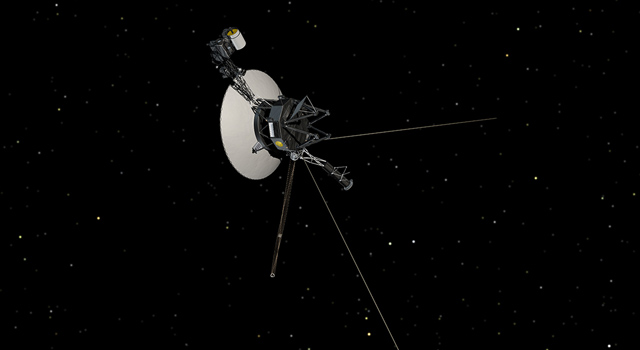News | April 20, 1989
Voyager 2 Spacecraft Completes Last Change-of-Course Maneuvers

NASA's Voyager 2 spacecraft, only four months away from its flyby of the planet Neptune, today completed one of the last major change-of-course maneuvers it will make before reaching the planet in August.
Voyager 2, launched in 1977, is operated by the Jet Propulsion Laboratory, Pasadena, Calif. Today's maneuver aimed the spacecraft toward the point at which it will most closely fly by Neptune, passing just 4,850 kilometers (3,013 miles) from the planet's cloud tops at 9 p.m. Pacific Daylight Time on Aug. 24, 1989. Five hours later, the spacecraft will fly about 39,000 kilometers (24,000 miles) from Neptune's moon Triton.
The maneuver was started at 11:01 a.m. and ended at 1:20 p.m. (PDT), according to Voyager mission controllers at JPL.
In addition to adjusting the course of the spacecraft, today's trajectory change served as the first and only rehearsal for similar maneuver that the spacecraft will execute when Voyager is just four days from its closest approach to Neptune. The technique is called roll-turn maneuver. Instead of using the spacecraft's trajectory correction thrusters to propel the spacecraft, mission controllers use the on-board gyroscopes to cause Voyager to roll in given direction. The manuever keeps Voyager's radio dish facing antennas on Earth throughout the maneuver and allows mission controllers to remain in contact with the spacecraft.
This technique will be especially critical when mission controllers fine-tune Voyager's course in August. It will prevent the signal command blackout that would occur if the usual propulsive maneuvers were performed. Using the roll-turn technique then will ensure the ability to send Voyager the set of computer commands that the spacecraft needs to carry out the most critical activities of the Neptune flyby.
Voyager 2 is now 4.293 billion kilometers (2.668 billion miles) from Earth. It is controlled by radio commands sent from giant NASA dish antennas in California, Spain and Australia. The spacecraft is so far away that information radioed at light speed (186,000 miles per second) takes nearly four hours to reach the Earth.
The Neptune flyby will be Voyager 2's fourth and final planetary encounter before the spacecraft heads out of the solar system to explore interstellar space.
Voyager 2 was launched in 1977, as was twin spacecraft, Voyager 1. Voyager 1 completed flybys of Jupiter and Saturn and their moons, and is headed out of the solar system. After its Jupiter and Saturn encounters, Voyager 2 was sent on to explore Uranus, which it flew past in January 1986, and Neptune. The spacecraft is now about 183 million kilometers (114 million miles) from Neptune.
The Voyager project is managed by JPL for NASA's Office of Space Science and Applications.
